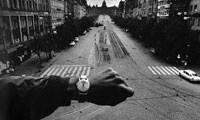 Museum panel asks, 'Is photography over?'
Museum panel asks, 'Is photography over?' "Prague, 1968," by Josef Koudelka, might illustrate the question "Is Photography Over?"
Recently the San Francisco Museum of Modern Art brought together 13 experts in the field to grapple with the question "Is Photography Over?"
Despite its taking place in SFMOMA's auditorium, well-equipped to project images in any medium, no symposium participant showed a single picture. Scores of them hang upstairs (through June 27) in "The View From Here," the museum's 75th-anniversary survey of California photography.
The reasonable presumption seemed to be that everyone in the audience has seen and snapped, and perhaps even printed, so many photographs that no precise reference points were needed.
Still, as a critic I found it troubling that no one seemed to want to get more specific than to drop names, almost as if photography and photographs counted as separate subject areas. Even in the 500-word statements that each guest was asked to submit in advance, only UCLA art historian George Baker centered his remarks on a detailed example, describing and discussing Moyra Davey's 1990 photo series "Copperheads." (All the texts are available at www.sfmoma.org/pages/research_proj ects_photography_over.)
Lack of images
If only Baker had devoted his time on the panel to showing some of these images and commenting on them, he might have anchored the entire colloquy in a way that it needed.
SFMOMA associate curator of photography Corey Keller acknowledged the symposium title question as "a blunt instrument," intended to elicit wide-swinging responses.
She suggested revising it to: "If something with photography is over, what is it?"
Curator and New Yorker contributor Vince Aletti had the best - at least, the most direct - answer in his written statement. "What is over is the narrow view of photography - the idea that the camera is a recording device, not a creative tool, and that its product is strictly representational - not manipulated, not fabricated, not abstract ..."
Aletti anticipated several other contributors' remarks, such as Joel Snyder's and Philip-Lorca diCorcia's, when he wrote "photography isn't merely a window on the world, it's a portal into the unconscious, wide open to fantasies, nightmares, obsessions and the purest abstraction."
Walead Beshty, an artist who uses photographic techniques, took the most detached view in his written and spoken remarks, suggesting that "photography," as the word was used in the symposium's title "becomes ... a way to name (an) institutional anxiety, and any perceived crisis is really that of the disciplinary structures applied to it. ... It is less a crisis for the medium, but more of criteria for what is excluded and what is included in the hypothetical warehouse called 'photography,' " of which museums are the most conspicuous custodians.
Trevor Paglen, an artist who teaches geography at UC Berkeley, took a detached view from a very different angle. " 'Photography' for me," he wrote, "denotes a wide range of imaging practices ... dialectically enmeshed with the construction of practical reality. ... This includes everything from 'art' photography to iPhone snapshots, from MRI scans to the infrared eyes of CIA predator drones, and from surveillance cameras attached to facial-recognition software to minoritarian documentary practices from Rodney King to Abu Ghraib."
"We can't divorce imaging technologies from uses of power," Paglen said during the Thursday evening session, echoing his written reference to Paul Virilio's coinage of the term "sight machine" for the coalescence of imaging devices and their data that digital technology has permitted.
I am probably not alone in wishing that Paglen had spoken more on stage.
Anxiety-inducing
Following private sessions among the participants before the Friday afternoon public event, SFMOMA curator of education Dominic Willsdon emphasized digital technology as an anxiety-inducing novelty that made the question "Is Photography Over?" seem timely.
Keller mentioned that as a curator, she has seen in unsolicited submissions "an incredible decline in quality, because photographers don't know how to make their own prints."
Several other participants - including Snyder, Baker, diCorcia and novelist and critic Geoff Dyer- echoed the concern that something, even if they could not agree on what, has been lost with the rise of digital technology. At some point Dyer cited Chuck Close's quip - when explaining his recent use of daguerreotype - that "photography never got any better than it was in 1840."
Old and new
Aletti admitted that he usually finds it impossible to distinguish between digital and darkroom prints, and New York Museum of Modern Art photography curator Peter Galassi repeatedly argued for continuity between old and new photo technologies, as regards their creative potential.
"Digital is insuring photography's future life," Galassi said on Friday afternoon, which led to an exchange in which Keller mentioned that the digital generation simply dumps pictures much more easily and frequently than its predecessors.
Dyer said, "Maybe it's the photographer that's over."
Crucial questions
At the symposium's end, it seemed that more discussion and dialogue with the audience - which included many noted photographers - and fewer panelists might have been more productive. Not of answers, but of consensus on the crucial questions pertaining to photography's nature and future. {sbox}
 Museum panel asks, 'Is photography over?'
Museum panel asks, 'Is photography over?'